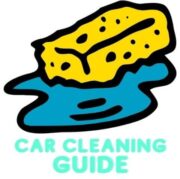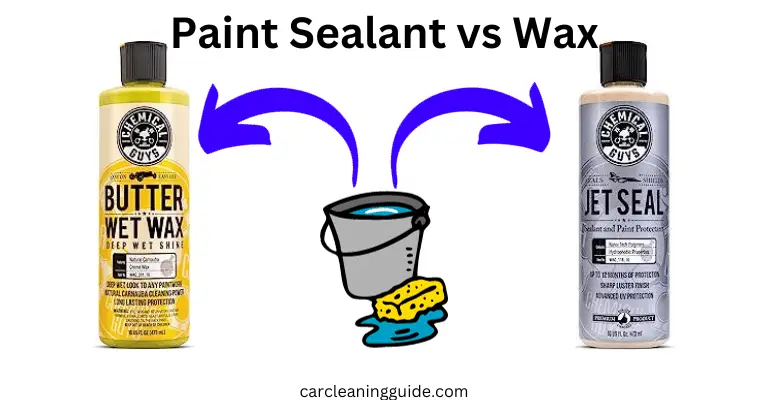Last Updated on November 25, 2023 by Chase Manhattan
- How to Clean Car Carpets Quick and Easy - July 10, 2024
- Can You Touch Up Clear Coat? Yes and No (Here’s Why) - November 25, 2023
- How To Wax A Car By Hand: A Comprehensive Guide - November 14, 2023
In the world of car detailing, the debate between paint sealants and waxes has been ongoing for years. Both products aim to protect and enhance the appearance of a vehicle’s paint, but they do so in slightly different ways and offer varied benefits. This article will delve into the intricacies of both, helping you make an informed decision for your vehicle.
Quick Navigation
Which Is Better: Paint Sealant or Wax (It Depends)
The battle between paint sealant and wax isn’t about which is universally better, but rather which is more suitable for specific circumstances. For instance, if you’re looking for a natural, deep shine and are willing to reapply the product frequently, wax might be your best bet. On the other hand, if you’re after long-lasting protection with a consistent shine, paint sealant could be the way to go.
Overview of The Benefits Of Using Wax
- Natural Shine: Wax, especially carnauba wax, gives a deep, natural shine that many car enthusiasts love.
- Protection from UV Rays: It acts as a shield against harmful ultraviolet rays that can fade car paint.
- Water Beading: Wax makes water bead up, which can help prevent water spots.
Wax has been a staple in car care for decades. Derived primarily from natural sources like the carnauba plant, waxes offer a unique, deep shine that many car enthusiasts swear by. This shine from applying wax isn’t just about aesthetics; it also provides a layer of protection against harmful UV rays, which can cause paint to fade over time. The water beading effect that wax introduces ensures that water droplets roll off the car’s surface, reducing the risk of potential paint damage and water spots.
Paint Sealant Benefits Compared To Waxing Your Car
| Benefit | Paint Sealant | Wax |
|---|---|---|
| Longevity | Lasts longer (up to 6 months or more) | Requires reapplication every 2-3 months |
| Shine | Consistent, glossy shine | Deep, natural shine |
| Protection | Better against contaminants & minor scratches | UV protection & water beading |
Paint sealants are the modern answer to car paint protection. These synthetic products are engineered to provide a longer-lasting protective layer compared to traditional waxes. With their chemical composition, sealants bond more effectively with the car’s paint, ensuring a consistent, glossy shine that can withstand the elements. The protective layer from sealants is often more resilient against contaminants, minor scratches, and the harsh effects of the environment.
What Do They Have In Common?
Both paint sealants and waxes serve the primary purpose of protecting your car’s paint from external elements. They both offer a level of shine, enhance the car’s appearance, and provide a protective layer against contaminants.
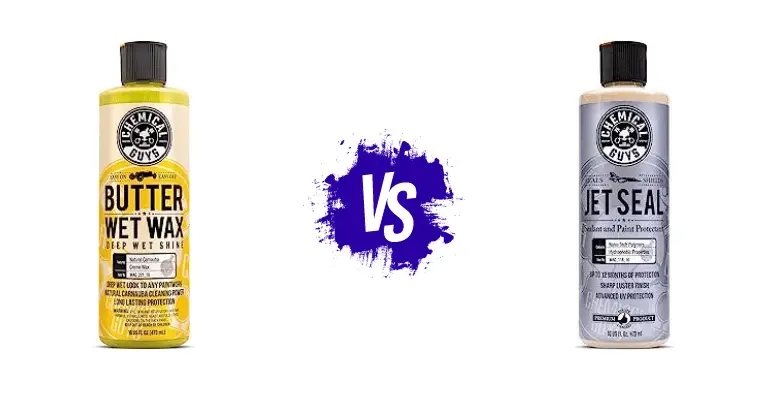
How Do They Differ?
- Composition: Waxes are often made from natural ingredients like carnauba, while paint sealants are synthetic.
- Durability: Sealants last longer than waxes.
- Finish: Waxes give a warm glow, while sealants offer a glossy, mirror-like finish.
While both products serve a similar primary purpose, their differences lie in their composition and the type of finish they provide. Waxes, especially those made from natural ingredients, offer a warm, deep glow that many find appealing. Paint sealants, being synthetic, provide a high-gloss, mirror-like finish that’s especially noticeable under sunlight. The durability of sealants often surpasses that of waxes, making them a favorite for those who prefer less frequent applications.
Learn more: How To Wax A Car By Hand: A Comprehensive Guide
Examples of When Wax Is Better
- Classic Cars: Wax provides that classic, deep shine that’s perfect for vintage vehicles.
- Quick Shine: If you’re preparing for a car show or event and need a quick shine, wax is the way to go.
For classic car enthusiasts, nothing beats the deep, rich shine that a quality wax provides. It accentuates the curves and lines of vintage vehicles, giving them a nostalgic glow. If you’re in a hurry and need a quick shine boost before an event or a car show, a good wax can provide instant results, making your vehicle stand out.
When Paint Sealant May Be Better
- New Cars: Sealants provide robust protection, ideal for newer vehicles.
- Harsh Environments: If you live in an area with extreme weather conditions, a sealant might offer better protection.
For those who have invested in a new car, providing it with the best protection is often a priority. Paint sealants, with their robust protective properties, are ideal in such scenarios. If you reside in an area with extreme weather conditions, be it heavy rainfall or intense sun, a sealant can offer the comprehensive protection your vehicle needs.
Food for thought: Should You Wax New Cars? Here’s What To Know
Consider The Cons
| Product | Cons |
|---|---|
| Wax | Shorter lifespan, affected by high temperatures, frequent reapplications required |
| Paint Sealant | Harder to apply, lacks the “warm” shine of waxes, can be pricier |
While both waxes and sealants have their merits, they also come with drawbacks. Waxes, for instance, don’t fare well under intense heat and may degrade faster, requiring more frequent applications. Paint sealants, on the other hand, can be trickier to apply correctly. Their synthetic nature might not provide the warm shine that natural waxes do, and they can be pricier.
How Many Types of Waxes Are There
- Carnauba Wax: Offers a deep shine and is derived from the leaves of the carnauba palm.
- Synthetic Wax: Made from artificial ingredients, it’s durable and easy to apply.
- Liquid Wax: Easier to apply than paste waxes and offers a decent shine.
- Spray Wax: Great for quick touch-ups.
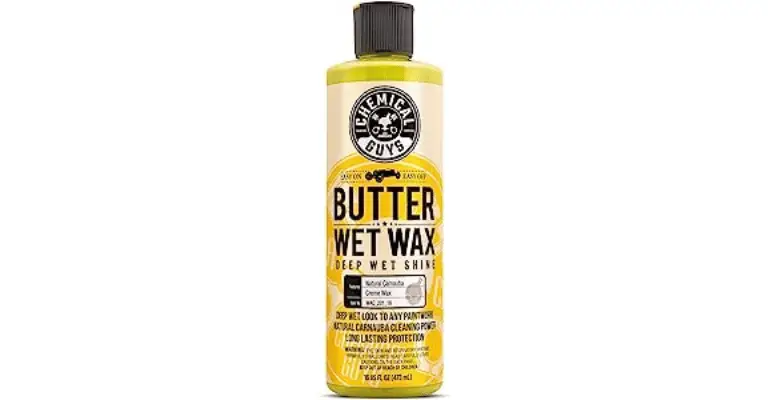
The world of car waxes is diverse, with each type catering to different needs. Carnauba wax, for instance, is renowned for its unparalleled shine, while synthetic waxes are praised for their durability. Liquid waxes offer a balance between ease of application and shine, whereas spray waxes are perfect for those quick touch-ups, especially after a wash.
What About Paint Sealant? (How Many Types)
- Polymer-Based Sealants: Made from chains of polymers, they bond well with the car’s paint.
- Acrylic-Based Sealants: Offers a high-gloss finish and excellent protection.
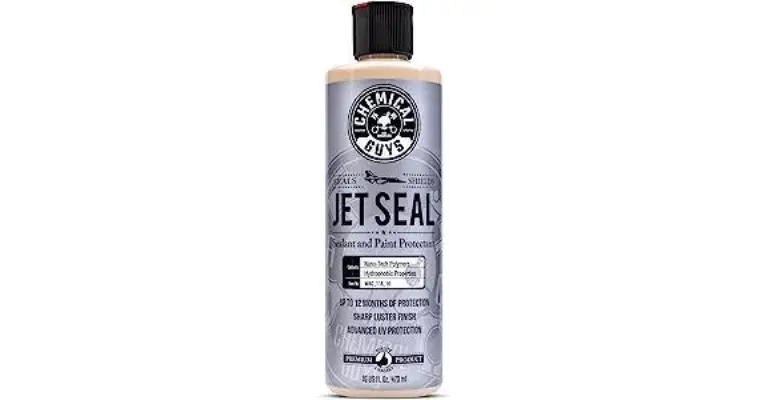
Paint sealants, though not as varied as waxes, come in different formulations. Polymer-based sealants are popular for their strong bonding properties, ensuring the sealant stays on the car for longer. Acrylic-based sealants, on the other hand, are known for their high-gloss finish, making cars look freshly detailed.
Are They Applied The Same Way?
he application process for both waxes and sealants is similar, but there are nuances. For instance, sealants often require a cleaner surface to bond effectively and might need to be left on the car longer before buffing. Waxes, especially liquid and spray variants, can be more forgiving and quicker to apply.
How Does Each Effect The Car’s Paint?
Protection is the name of the game for both waxes and sealants. While waxes provide a protective layer that enhances the depth and color of the paint, sealants bond at a molecular level, offering a more robust defense against potential harm. This bonding ensures that contaminants, minor scratches, and UV rays have a harder time damaging the paint. Waxes, on the other hand, provide a protective layer that enhances the paint’s depth and color.
Which Lasts Longer?
In the battle of longevity, paint sealants generally come out on top. Their synthetic composition allows them to withstand the elements better than waxes. While a quality sealant can last up to 6 months or even more, waxes, especially natural ones, might require reapplication every 2-3 months.
Which Is Cheaper?
Budget often plays a role in the decision-making process. In general, natural waxes tend to be more affordable than synthetic paint sealants. However, considering the longevity of sealants, they might offer better value in the long run.
Which Is Easier To Apply?
Ease of application can vary based on the product and the user’s experience. Generally, waxes, especially in liquid or spray form, are easier and quicker to apply. Sealants, while offering longer protection, might require a bit more expertise to ensure a streak-free finish.
Which Would I Recommend? It Depends (Here’s Why)
The decision between wax and paint sealant isn’t a one-size-fits-all answer. It boils down to what you prioritize more: the warm, deep shine of a wax or the long-lasting, glossy finish of a sealant. Consider factors like your car’s age, the environment it’s exposed to, and how often you’re willing to reapply the product.
Read next:
> How To Protect Paint Without Clear Coat 101
> Can You Touch Up Clear Coat? Yes and No (Here’s Why)
How To Decide For Yourself
When choosing between wax and sealant, consider your car’s specific needs and your personal preferences. Think about the environment your car is exposed to, the look you’re aiming for, and the level of protection you desire. By weighing the pros and cons of each, you can make an informed decision that’s best for your vehicle.
Recap of Main Talking Points
In conclusion, both paint sealants and waxes offer valuable protection for your car’s paint. While waxes provide a natural, warm shine and are often more affordable, sealants offer longer-lasting protection with a glossy finish. The choice between the two depends on various factors, including your car’s age, the environment, and your personal preferences.
Read next: Ceramic Coat vs Wax
Conclusion
The debate between paint sealant and wax is a testament to the advancements in car care products. Whether you’re a classic car enthusiast or a proud owner of a brand-new vehicle, there’s a product out there that’s perfect for your needs. By understanding the benefits and drawbacks of each, you can ensure your car remains protected and looks its best for years to come.
FAQs
Why do some car enthusiasts prefer wax over paint sealants?
While both wax and paint sealants serve to protect and enhance a car’s paint, many enthusiasts have a soft spot for wax due to its natural origins, especially carnauba wax. Wax imparts a deep, rich shine that’s hard to replicate, giving the car a classic, well-maintained look. This nostalgic glow, especially on vintage cars, is a big reason why many prefer wax.
Can I combine both wax and paint sealant for maximum protection?
Yes, some car owners use both products to get the best of both worlds. Typically, a paint sealant is applied first for its long-lasting protection, followed by a layer of wax to achieve that deep, warm glow. However, it’s essential to ensure compatibility and wait for the sealant to cure fully before applying wax.
How often should I reapply wax or paint sealant to keep my car looking its best?
The frequency of reapplication depends on the product and environmental factors. Generally, waxes need reapplication every 2-3 months, while paint sealants can last up to 6 months or more. However, if your car is frequently exposed to harsh conditions, such as intense sunlight or heavy rainfall, you might need to reapply the products sooner.
Are there any environmental concerns associated with using paint sealants?
Most modern paint sealants are formulated to be eco-friendly. However, it’s always a good idea to check the product’s label or consult the manufacturer. Some enthusiasts prefer natural waxes, like carnauba, due to their organic origins, which have minimal environmental impact.
How can I ensure the best results when applying wax or paint sealant?
For optimal results, always start with a clean, dry car. If you’re applying a paint sealant, ensure the car’s surface is free from any contaminants. Follow the product’s instructions carefully, and consider using a microfiber cloth for buffing. Regular maintenance, like washing your car and keeping it protected from harsh elements, will also prolong the effects of both wax and sealant.
